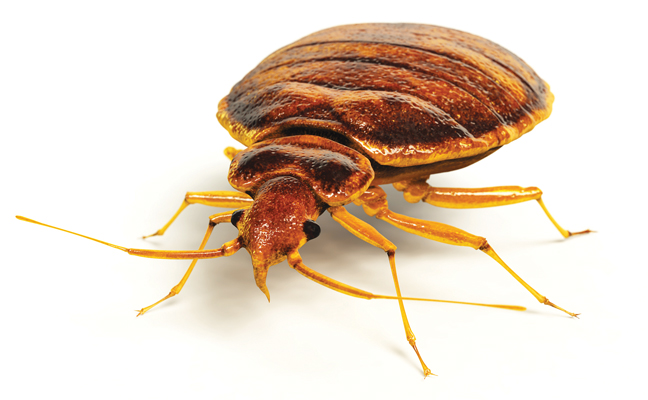
Photo: animatedfunk/E+/Getty Images
Bed bugs (Cimex lectularius) survive by feeding on the blood of warm-blooded creatures, including humans, and contributed to a significant increase in global infestations in recent years1. Their elusive nature, hiding in concealed cracks, crevices, and voids, makes them challenging to eradicate. Moreover, they exhibit remarkable survival abilities, enduring extended periods without feeding, lasting from four to 18 months depending on environmental conditions2. Alarmingly, the resurgence of bed bugs globally has underscored their resistance to many commonly used insecticides3.
While bed bugs do not transmit infectious pathogens, their bites can inflict significant discomfort, leading to financial losses and a diminished quality of life. Infestations also carry psychological and social ramifications — causing stress, anxiety and sleep disturbances among affected individuals4. Consequently, addressing bed bug infestations promptly and effectively is crucial to mitigate their negative impact. Early detection and intervention play vital roles in preventing their spread and minimizing adverse effects.
Accurate identification of bed bugs is crucial for effective prevention and management. Adult bed bugs are oval-shaped, flat and typically measure less than 0.25 inch long. Nymphs resemble adults, but are smaller. They are initially nearly colorless, gradually developing a brownish hue as they mature. Female bed bugs lay white, sticky, pear-shaped eggs, each approximately 0.03125 of an inch long, in concealed areas such as cracks, crevices or voids in mattresses, box springs, furniture, walls and ceilings.
Unlike mosquitoes, fleas or midges, both adult bed bugs and their immature stages are bloodsuckers2. Confusion may arise between bed bugs and bat bugs (C. pilosellus) because of their visual similarities. However, a distinguishing feature becomes evident under a stereoscope with magnification between 20x and 50x: The fringe hairs on the pronotum (the upper covering of the thorax) of the bat bug are as long as or longer than the width of the bug’s eye, whereas they are shorter in bed bugs5. This microscopic difference is crucial for accurate species identification, as treatments for bat bugs significantly differ from those for bed bugs. Therefore, precise identification is essential for effective management.
Prevention considerations
Understanding the mechanisms of bed bug spread is crucial for preventing infestations. These pests can actively traverse walls, ceilings and doorways, and they often hitchhike on clothing or infested items. Gravid females, frequently found apart from groups, play a significant role in their dispersal6. Human activities, such as breathing and emitting chemical signals resembling occupancy, affect their movement, particularly in multi-housing environments7.
However, if hosts are absent for an extended period, as in the case of vacant apartments, bed bugs may reduce their search activity to conserve energy8, it’s essential to educate oneself and others about bed bugs’ characteristics and behaviors because not all bites are caused by them4. Preventive measures like inspecting belongings during travel, carefully checking secondhand furniture before bringing it home, and properly disposing of infested items are crucial. Additionally, reducing clutter and sealing cracks are vital steps in prevention.
Using approved encasements for mattresses and box springs can also strengthen prevention efforts. Regular inspections, monitoring and timely intervention are essential for effective management in both commercial and residential settings1,2,3.
Timely identification, comprehensive understanding of behaviors, and proactive preventive measures are imperative for the effective management of bed bug infestations and mitigating their impact on human health and well-being.
References
- Potter, M.F. (2008). “The business of bed bugs,” Pest Management Professional. 76(1): 24-40
- Usinger RL, 1966. Monograph of Cimicidae, College Park, Md.: Thomas Say Foundation, Entomological Society of America. vol. 7.
- González-Morales, M.A., Devries, Z., Sierras, A., Santangelo, R.G., Kakumanu, M.L., and Schal, C. (2021). “Resistance to Fipronil in the Common Bed Bug (Hemiptera: Cimicidae).” Journal of Medical Entomology, 58(4), 1798-1807. https://doi.org/10.1093/jme/tjab040 and Romero, A., M.F. Potter, D.A. Potter and K.F. Haynes. (2007), “Insecticide Resistance in the Bed Bug: A Factor in the Pest’s Sudden Resurgence?” Journal of Medical Entomology, Volume 44, Issue 2, 1 March 2007, Pages 175–178, https://doi.org/10.1093/jmedent/44.2.175
- Doggett, S.L., Dwyer, D.E., Peñas, P.F., and Russell, R. C. (2012). “Bed bugs: clinical relevance and control options.” Clinical Microbiology Reviews, 25(1), 164-192.
- US Department of Health, Education, and Welfare. 1969. “Pictorial keys to arthropods, reptiles, birds, and mammals of public health significance.” Centers for Disease Control, Atlanta, Ga.
- Goddard, J., Caprio, M., and Goddard Jerome, I. (2015). “Diffusion rates and dispersal patterns of unfed versus recently fed bed bugs (Cimex lectularius L.).” Insects, 6(4), 792–804. https://doi.org 10.3390/insects6040792 and Hentley W.T., Webster B., Evison S.E.F., and Siva-Jothy M.T. (2017). “Bed bug aggregation on dirty laundry: a mechanism for passive dispersal.” Sci. Rep. 7: 11668 and Pfiester, M., Koehler, P.G., and Pereira, R.M. (2009). “Effect of population structure and size on aggregation behavior of Cimex lectularius (Hemiptera: Cimicidae).” Journal of Medical Entomology, 46(5), 1015–1020. https://doi.org/10.1603/033.046.0506
- Suchy, J.T. and Lewis, V.R. (2011). “Host-seeking behavior in the bed bug, Cimex lectularius.” Insects, 2, 22–35. http://doi.org/10.3390/insects2010022 and Wang, D., C. Wang, N. Singh, A.L. Eiden, R. Cooper and C. Zha. (2017). “Effect of feeding history and time elapsed from field collection on the movement behavior and response to stimulation in Cimex lectularius (Hemiptera: Cimicidae).” Journal of Economic Entomology. 110: 1719–1727. http://www.doi.org/10.1093/jee/tox148
- Romero, A., M.F. Potter and K.F. Haynes. (2010). “Circadian rhythm of locomotor activity in the bed bug, Cimex lectularius L.” J. Insect Physiol. 56: 1516-1522.
Leave A Comment